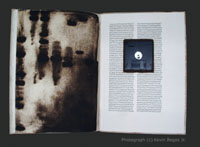Material related to the “hacking” of the self-encrypting diskette containing William Gibson’s poem and the release of its text onto the MindVox BBS on Dec. 10, 1992 (and subsequently into the wilds of the Internet). See Matthew G. Kirschenbaum’s discussion of the competing explanations of the “hack” and whether it was a code hack at all or instead a low-tech hack accomplished by transcribing from video footage shot at the screening of the poem at one of the “transmission” events of Dec. 9, 1992. Subsequent evidence, including the discovery of the original bootleg video recorded Dec. 9, 1992, at the Americas Society in New York City and correspondence with one of the video makers confirms that it was the low-tech hack that occurred. (See Kirschenbaum’s follow-up discussion.)
Archival Documents »The “Hack”
Agrippa»The Poem
 Agrippa the book contains a diskette buried in a hollowed-out cavity. When played in a 1992-era Mac computer, the diskette scrolls a 305-line poem by William Gibson unstoppably up the screen once, then performs an encryption-like effect on it that makes it “disappear” for all but the most determined hacker.
Agrippa the book contains a diskette buried in a hollowed-out cavity. When played in a 1992-era Mac computer, the diskette scrolls a 305-line poem by William Gibson unstoppably up the screen once, then performs an encryption-like effect on it that makes it “disappear” for all but the most determined hacker.Gibson’s text is a trans-generational memory poem about his father’s and his own youth—the father captured by a camera and a 1920 Kodak “Agrippa” brand photo album; the son reflecting upon the interface for a vanished world thus provided by the “mechanism.” Disappearance is a central theme (“Inside the cover he inscribed something in soft graphite / Now lost”). But the poem reimagines blurry human disappearance as an effect of sharp, decisive, binary transitions in an existential “the mechanism” (“The shutter falls / Forever / Dividing that from this”). Beyond elegy, the mechanism—which abides only in the moment, and so “forever”—also knows how to laugh (“tonight red lanterns are battered, / laughing, / in the mechanism”).
Currently, the Agrippa Files does not have permission to reproduce the full text of the poem. Many wild copies of the text exist on the Internet. The official copy is on William Gibson’s Web site.
Agrippa»Additional and Detail Photos
Additional and detail photos of the Archive-1 copy of Agrippa (a book of the dead).
Study Tools
Resources and tools to facilitate study of Agrippa on this site include an Itemized Inventory of materials collected in “The Book” and “Archival Documents” categories and the Virtual Lightbox.
Virtual Lightbox
The Virtual Lightbox is a browser-based Java tool for studying, juxtaposing, comparing, and resizing multiple images as if arranging slides on a “lightbox.” Users can also populate the lightbox with images from their own hard drives. Requires Sun Java® runtime environment 1.3+ plug-in.
Agrippa»Fading Ink Simulation
Artist Dennis Ashbaugh intended to print antique newspaper and photographic equipment catalog advertisements of technological artifacts (TV, phone, magic lantern, etc.) in “disappearing” ink over his copperplate aquatint etchings featuring DNA-gel motifs (not actual DNA stain patterns but aesthetic renderings). Exposing the pages to light or air were to have made these “overprints” gradually vanish, leaving behind just the underlying etchings. The art would thus have matched William Gibson’s disappearing poem, which disappears into encrypted code when played.
However, while some extant copies of the book contain overprints created in uncured photocopy toner as a gesture toward the original idea, technical problems prevented the implementation of the fading ink. The uncured-toner images blur over their base etchings and stain facing pages, but they remain.
However, while some extant copies of the book contain overprints created in uncured photocopy toner as a gesture toward the original idea, technical problems prevented the implementation of the fading ink. The uncured-toner images blur over their base etchings and stain facing pages, but they remain.
Click on thumbnail below for
digital simulation of the original concept.
digital simulation of the original concept.
Primary and Archival Materials Collected on This Site
Itemized inventory of materials collected in the “Agrippa” and “Archival Documents” categories.
Bibliography » Untraced Works
In the process of researching the bibliography for this project, the Agrippa Files editors occasionally come across resources whose originals have not yet been located, whose citations are incomplete, or whose existence has not been verified. This category is a temporary holding place for such citations pending their completion or verification. (Users with information about these works are welcome to contact the Agrippa Files project.)
Archival Documents »Source Images
Source images from New York Hudson River Valley area newspapers and photographic equipment catalogs of the 1920’s and 1930’s used by Dennis Ashbaugh as the basis for “overprints” in Agrippa. The original plan was to print these images in “disappearing” or “fading” ink over the copperplate aquatint etchings in the book featuring Ashbaugh’s distinctive DNA-gels motifs. Opening the book and exposing the etchings to light or air would make the images gradually vanish, leaving behind only the DNA look. However, technical problems prevented the implementation of the fading ink, though an attempt was made to realize the concept in uncured photocopy toner. (See digital simulation of a fading overprint.)
Work with images in Virtual Lightbox
Bibliography » Miscellaneous
Miscellaneous items relating to Agrippa.
